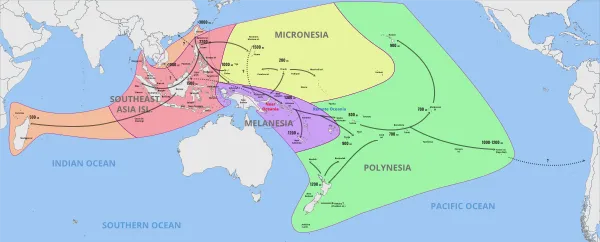Who were the first New Zealanders? Addressing disinformation regarding Māori as not indigenous, part 2
Hamish Dickson - 3rd February 2025
In the first part of this article, I looked at some of the common archaeological misconceptions used to spread doubt about Māori being the first to settle New Zealand. Having spent some time debunking some of the more common ideas floating around on social media, which are supposedly covered up to hide the “truth”, this second part will be devoted to looking at the more widely accepted versions of historical events.
Who were the first New Zealanders?
Through DNA sequencing of archaeological material (including botanical and zoological) as well as linguistics, strong migration patterns have emerged over decades of research by experts, many of whom have dedicated their careers to unravelling the early history of habitation of our part of the world. Linguistic evidence puts the beginning of an eastward movement toward the Pacific from Taiwan at around 3000 years ago. These peoples moved into Melanesia and Micronesia, before developing a material culture known as Lapita. The Lapita culture is noted for using stylised pots with dentate-stamped pottery. The significance of this pottery is that it covers a large expanse, covering the Western Polynesian Islands of Fiji, Samoa, and Tonga by around 900 BC. There has even been Lapita found in Madagascar, but no evidence for a permanent settlement has yet been found. For some unknown reason, pottery manufacturing was discontinued by the early Polynesians, before they made another eastward journey to the Cook Islands and French Polynesia, such as the Marquesas, around 700 AD. From there, they expanded further to Hawaii by 900 AD, Rapa Nui (Easter Island) by 1000 AD, and finally Aotearoa by the late 1200s.

According to many of the advocates for a European indigenous population of New Zealand, Māori just “drifted” here. This belief is, of course, often grounded in ill-concealed ignorance and racism. Early research with computers in the 1960s first calculated (using known wind and tidal patterns) that to drift to the Pacific Islands is impossible, concluding that the Polynesians both knew what they were doing and where they were going. In 1976 a double hulled canoe set out from Hawaii on a mission to sail to French Polynesia and back, using traditional navigation methods. It was a success.
One method often cited as to why Polynesians could not find their way below the equator was that they could not see the North Star, which always points North. Never mind that wee barrier, for our innovative Polynesians. If you look at the Southern Cross and go 5 lengths of that constellation to the right, and then straight down to meet the horizon, you have South. It never changes. Other methods used were types of seaweed and clouds, and fish and sea bird species. Some bird species only fly a short distance from land, so it is just a matter of following them to find your way to the nearest island. With the triangular sails of a double hull canoe, tracking against the wind was also possible, allowing Polynesians to sail in any direction. Europeans didn’t develop the triangular or lateen sail until the 16th Century!
The Polynesians arrived in Aotearoa
Humans are destructive creatures, and this was the case in New Zealand when the first humans arrived. Wherever they go, humans destroy parts of their environment. They introduce noxious species, such as the pacific rat in New Zealand (Rattus exulans, or kiore to the Māori), a special that eats birds’ eggs. Humans also cause fires, either to clear land or by accident. Over-predation of avian populations who have never encountered mammals, let alone humans, also marks a massive and measurable change in New Zealand, which is reflected in the archaeological record in the form of extinctions.

For New Zealand, a major depletion of avian species shortly followed the earliest known contact with humans, at around the late 13th century. The moa was pretty much wiped out in some regions within fifty years, and gone completely from both main islands around 500 years ago. These events are the strongest evidence that there was no human habitation in New Zealand before this time. There are no human remains, no evidence of tools, and no mass extinctions of avian fauna before the end of the 13th Century.
Among the earliest, and certainly best investigated, sites where Polynesians first settled in Aotearoa is Wairau Bar, or Te Pokohiwi, which is located in Marlborough at the top of the South Island. The site dates to as early as 1280 AD, and was occupied for around 20 years on two separate occasions. Earlier dating of this site was a function of poor collection, as the samples turned out to be from charcoal wood that was older than the site. So the date of the site was eventually revised from 1200BP to around 700BP. A date from a moa eggshell put the date closer to the 1300s. Egg shells are good for getting dates, as they are often only days or weeks old when humans interact with them.
Early excavations of the Wairau Bar site in the 1950s meant some human burials (kōiwi tangata) had been excavated and taken to the Canterbury Museum for study. This upset the local Iwi, who resented it to the point of not collaborating with the crown for decades on issues regarding the site. This eventually changed when the Iwi later approached Professor Richard Walter at the University of Otago. For many years, archaeological research on indigenous sites in New Zealand has been carried out in partnership with local Iwi. This was the case for this site and, in 2009, research findings were released to the public. Some of the uncovered artefacts match the morphology of artefacts found in the Cook Islands dating to about the same time of occupation.
Stable isotopic analysis is a good way of finding out where someone likely spent the first few years of their life. The ratios of strontium isotopes in soils can vary depending on what part of the world you live in. By ingesting food and water, strontium gets absorbed in teeth during the first years of one’s life, and then remains fixed there. So these isotope levels can indicate the mobility of an individual, and allow archaeologists to find out if they were born near the place they were buried. The analysis done on kōiwi tangata at the Wairua Bar site indicated that at least some of the individuals were not local, and were likely the first arrivals to New Zealand from Eastern Polynesia.
DNA analysis indicates the people buried at the site had DNA profiles consistent with those from French Polynesia. Also, a turret shell was found at the site, which is only found in East Polynesia and common in sites on the Society Islands at the time of occupation.
Through the partnership between Otago University and the local Iwi, the reburial of remains was carried out. A partnership of mutual understanding like this is a far cry from the sort of pseudo-archaeology we see conducted by cranks digging up a “stone wall” in the Kaimanawa, or disturbing human remains looking for red-headed giants. Here is a short video of how archaeology is undertaken by professionals in New Zealand:
And this page has some great resources for more reading on the Wairau Bar site.
A recent personal communication between Professor Walter and myself has revealed there were a great deal of colonisation voyages from East Polynesia to New Zealand, voyages that potentially lasted 3 generations. This of course implies not only two-way voyaging, but also multiple landings - which may have sparked stories of previous inhabitants, as described by Barry Brailsford (and mentioned earlier in my previous article).
Politics
My online experience leading up to the 2023 election of right-leaning facebook pages gave me the impression that there may have been actors deliberately spreading disinformation in order to influence the elections toward a less Māori-friendly coalition. Much of the disinformation followed the outline of what I described in my previous article, of Europeans being in Aotearoa before Māori (sometimes even claiming that Māori literally ate these Europeans). This fostered a lot of “they did it to us, we’ll do it back” mentality.
One common type of disinformation was in the form of pictures of alleged stone structures hidden in the New Zealand bush, claimed to be made by Celts. On numerous occasions I would cut and paste these images into google images, and their source would come up as anything from a sculpture made in the 20th century to old ruins in the northern hemisphere. Documentaries such as “Skeletons in the Cupboard” and Martin Duatre’s “Poukawa Revisited” were plastered several times in different Facebook groups.
The 2023 Australian “Indigenous Voice” referendum was designed to help Aboriginal and Torres Strait peoples to provide non-binding advice to lawmakers on issues facing indigenous Australians, much like Māori wards do for councils in New Zealand. Support for the referendum in Australia was over 75% when it was first proposed, but slumped to around 40% toward the election date. The “No” vote eventually won the referendum. This referendum was just to let indigenous people work with lawmakers to give advice on issues that affect them - nothing more. The Australian Associated Press (AAP) FactCheck team who monitors Instagram, Facebook and TikTok found that the amount of disinformation spread on these media outlets exceeded that before the Australian 2022 election.

I would not be surprised if we see something similar leading up to the Māori ward referendum, as indigenous issues become salient. AAP said they had seen bot-like behaviour, as disinformation was simultaneously spread across a number of sites. Disinformation often took the form of claiming a hidden agenda by indigenous Australians to take their land back. Also pedalled, amongst other garbage, was the idea that the Australian referendum would spark division between white and indigenous Australians. This is the same rhetoric that we now see spouted by David Seymour about the Māori Wards.
For those who are not familiar with New Zealand politics, David Seymour is the leader of a party that formed a coalition with two other parties to form our government. There is evidence Mr Seymour has strong links with a right wing think tank known as the Atlas Network.
Some academics and news publications have linked the Atlas Network to oil and gas producers, to efforts opposing governments’ and activists’ efforts against climate change, and to the spreading of climate change denial, including the idea that wind farms kill whales. Atlas Network collaborated with another think tank, the Macdonald-Laurier Institute of Canada, in a push for oil and gas development on indigenous land, according to documents described in The Guardian. The Atlas network has also been responsible for funding the disinformation that changed attitudes during the Australian Indigenous Voice referendum. It has been argued that what happened in Australia with the referendum may be repeated here with our founding document - The Treaty of Waitangi.
There are politicians trying to align themselves with these fringe voting groups. Dog whistles from Winston Peters to the far-right do not help, when he says things like that Māori are not indigenous to New Zealand, or that every New Zealander is a coloniser of New Zealand. He also said that Australian aboriginals are indigenous to Australia as they have been there for sixty-five thousand years, whereas Māori are not indigenous as they have only been here for seven or eight hundred years. What Peters neglects to mention is that it took hominids 2.5 million years to get from Olduvai Gorge in Tanzania to the last bastion on earth - Aotearoa.
Conclusion
There is no tangible evidence that anyone was here in New Zealand before the 13th Century. However, there is a lot of evidence humans were here from 1300 AD onwards, and that those humans came from Polynesia. Humans are simply too destructive to leave no trace upon their arrival at new lands. The sudden extinction of Moa and other birds, as well as evidence of major bushfires, is testimony to this.
A group of people with a stone-age culture and a passion for exploring took big risks and made it to the last major landmass on earth to be colonised by humans. They crossed the vast Indian Ocean to reach Madagascar, and then the largest ocean - the Pacific - to reach South America. Much of this occurred before those in Europe were brave enough to lose sight of land. There is a lot of evidence for two-way voyaging across the Pacific, which means the travellers knew where they were going, and they were planning expensive expeditions to find new lands.
Clearly there is a racist component to the claim that Europeans were the first peoples to New Zealand. This appears to be a theme running through much of the far-right alternative media in New Zealand, such as Counterspin. The bottom line is, there is no evidence that humans were here in New Zealand before the Polynesians arrived in the late 13th Century. But even if there were people before those first Polynesian settlers to New Zealand, they never signed a treaty with the Crown - Māori did and that’s all that matters.